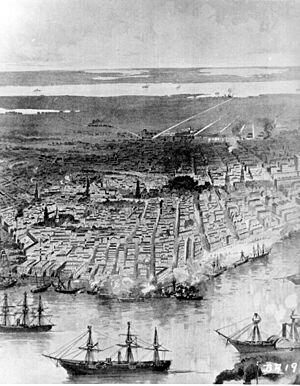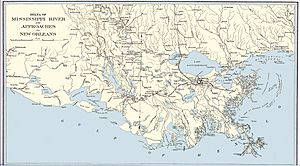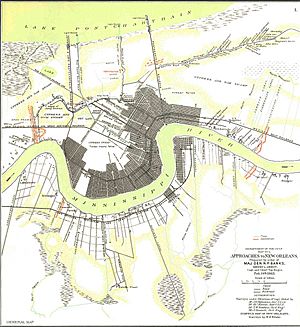New Orleans in the American Civil War facts for kids
New Orleans, Louisiana, was the biggest city in the Southern United States during the American Civil War. It was super important for the Confederate States Army because it provided military supplies and many soldiers. Its location near the mouth of the Mississippi River made it a key target for the Union. The Union wanted to control this huge river and stop the Confederacy from selling its valuable cotton.
In April 1862, a Union fleet led by Captain David Farragut attacked the two strong forts guarding the river. They managed to break through a defensive barrier between the forts. After passing the last Confederate defenses, they took control of the forts and then the city itself without more fighting.
The new military governor, Major General Benjamin Butler, helped keep order in the city. However, his methods made many people angry. He was later replaced by Nathaniel P. Banks, who improved relations. But Union soldiers stayed in New Orleans even after the war ended. Because the city surrendered quickly, it wasn't badly damaged. This is why many old buildings are still standing today.
Contents
New Orleans Before the War
New Orleans grew steadily over many years. By 1850, it was the 6th largest city in the United States. It was the only Southern city with over 100,000 people. New Orleans was also the biggest slave market in the country. This trade brought a lot of wealth to the city.
New Orleans: A Busy Port City
Before the Civil War, New Orleans was the main business center of the Deep South. Cotton made up half of its exports. Tobacco and sugar were also important goods. More than half of all cotton grown in the U.S. passed through the port of New Orleans. This was three times more than the next biggest port, Mobile. The city also had important government buildings. These included the New Orleans Mint and the U.S. Custom House.
Louisiana Joins the Confederacy
Louisiana decided to leave the Union on January 22, 1861. A few days later, a meeting in New Orleans allowed federal workers to keep their jobs. But they would now work for the state of Louisiana. In March, Louisiana approved the Constitution of the Confederate States. The New Orleans Mint was taken over. It was used in 1861 to make Confederate coins.
New Orleans: A Confederate Stronghold
New Orleans quickly became a major source of soldiers and supplies for the Confederate States Army. One early group was the "Washington Artillery," a pre-war militia artillery company. In January 1862, free black men in New Orleans formed a Confederate regiment. It was called the Louisiana Native Guard. They were not allowed to fight in battles. Instead, they defended areas around New Orleans.
Several local people became important Confederate leaders. These included P.G.T. Beauregard, Braxton Bragg, and Harry T. Hays. Hays commanded the famous Louisiana Tigers infantry. This group included many Irish American men from New Orleans.
The city was also a place where the Confederate States Navy stored weapons. Shipbuilders in New Orleans created new warships. These included the CSS Manassas, an early ironclad. They also built two submarines, the Bayou St. John submarine and the Pioneer. These submarines did not see action before the city fell. The Confederate Navy also defended the lower Mississippi River during the Battle of the Head of Passes.
Early in the Civil War, New Orleans became a key target for the Union Army and Navy. The U.S. War Department planned a big attack to take control of the city. This would cut off a major source of money and supplies for the new Confederacy.
The Fall of New Orleans
The importance of New Orleans made it a target for the Union early in the war. Captain David Farragut was chosen to lead the West Gulf Blockading Squadron in January 1862. His four large ships, along with nineteen smaller vessels and twenty mortar boats, gathered near the Lower Mississippi River.
Defending the Mississippi River
The main defenses of the Mississippi River were two strong forts: Fort Jackson and Fort St. Philip. These forts were made of stone and brick. They had powerful guns and were placed on each side of the river. This allowed them to control long parts of the river. The Confederates also had some ironclads and gunboats. But the Union Navy fleet had more ships and more powerful guns.
The Battle for the Forts
On April 16, the Union fleet moved into position below the forts. They prepared for the Battle of Forts Jackson and St. Philip. On April 18, the mortar boats began firing. Their shells hit accurately, and Fort Jackson was badly damaged. However, the forts were still strong. A big barrier, called a boom, was placed between the forts. It was designed to stop Union ships. Union gunboats tried to destroy the barrier at night, but they had little success.
Finally, on the night of April 23, two Union gunboats broke a gap in the boom. At 2:00 a.m. on April 24, Farragut's fleet started to move. Farragut led in his ship, the Hartford. After a tough fight with the forts and Confederate ships, almost all the Union fleet got past. The ships then sailed upriver past the Chalmette batteries. These were the last major Confederate defenses protecting New Orleans from a sea attack.
New Orleans Captured
At noon on April 25, Farragut's ships anchored in front of the city. Forts Jackson and St. Philip, which were cut off and still being shelled, surrendered on April 28. Soon after, Union soldiers marched into New Orleans. They took control of the city without any more fighting. This led to the capture of New Orleans.
New Orleans was captured without a battle inside the city itself. Because of this, it was saved from the destruction that many other Southern cities faced. Today, it still has a historic feel. Many 19th-century buildings stand far beyond the old French Quarter. The city was held by the Confederates for 455 days.
New Orleans Under Union Control
The Union commander, Major General Benjamin Butler, quickly put New Orleans under strict martial law. His harsh rule made people in both the South and North very angry. Many of his actions caused offense. For example, he took $800,000 that was stored at the Dutch consul's office. Butler was nicknamed "The Beast." He was also called "Spoons Butler" because some Union soldiers took silverware from local homes. There was no proof Butler himself was involved in this.
Butler ordered a message to be carved into the base of the statue of General Andrew Jackson. Jackson was a hero of the Battle of New Orleans. The message said: "The Union Must and Shall Be Preserved."
Butler's Controversial Rule
Another controversial act by Butler was the execution of William Mumford in June. Mumford was a Confederate supporter who had torn down the U.S. flag over the New Orleans Mint. This was against Union orders. Butler also put many uncooperative citizens in prison.
However, Butler's time in charge also had benefits for the city. He kept the city orderly. His large-scale cleanup efforts made New Orleans unusually healthy for the 19th century. But the international anger over Butler's actions helped lead to him being removed from command on December 17, 1862.
Major General Nathaniel P. Banks later took command in New Orleans. Under Banks, relations between the soldiers and citizens got better. But the bad feelings from Butler's rule lasted for decades. Union soldiers continued to occupy the city even after the war. They stayed through the early part of Reconstruction.
Civil War Heritage in New Orleans
Many important buildings and structures from the Civil War still stand in New Orleans. You can also see parts of the city's old defenses downriver and upriver at Camp Parapet.
On Camp Street, you can visit the Confederate Memorial Hall Museum. It was started in 1891 by war veterans. This museum has the second-largest collection of Confederate military items in the country. Only the Museum of the Confederacy in Richmond has more.
Notable New Orleans People of the Confederate Military
- P.G.T. Beauregard, Confederate general and inventor
- Judah P. Benjamin, United States Senator, Confederate Attorney General, Secretary of War and Secretary of State
- Albert G. Blanchard, Confederate general
- Harry T. Hays, Confederate general




